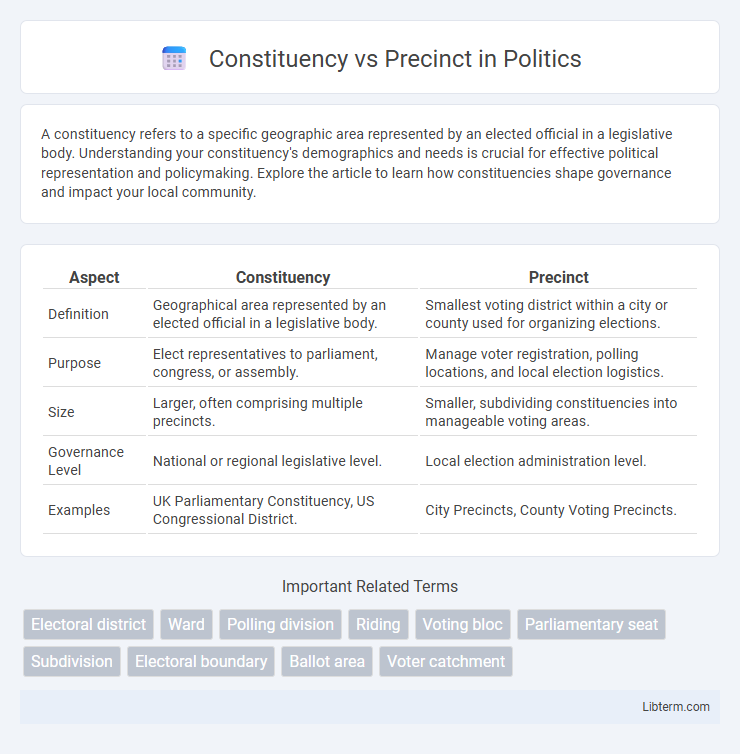A constituency refers to a specific geographic area represented by an elected official in a legislative body. Understanding your constituency's demographics and needs is crucial for effective political representation and policymaking. Explore the article to learn how constituencies shape governance and impact your local community.
Table of Comparison
| Aspect | Constituency | Precinct |
|---|---|---|
| Definition | Geographical area represented by an elected official in a legislative body. | Smallest voting district within a city or county used for organizing elections. |
| Purpose | Elect representatives to parliament, congress, or assembly. | Manage voter registration, polling locations, and local election logistics. |
| Size | Larger, often comprising multiple precincts. | Smaller, subdividing constituencies into manageable voting areas. |
| Governance Level | National or regional legislative level. | Local election administration level. |
| Examples | UK Parliamentary Constituency, US Congressional District. | City Precincts, County Voting Precincts. |
Understanding Constituency and Precinct: Definitions
A constituency refers to a geographically defined area represented by an elected official in legislative bodies, encompassing all eligible voters within its boundaries. Precincts are smaller administrative units within constituencies designed to organize voters for elections and facilitate efficient polling station management. Understanding these distinctions ensures clarity in electoral processes and effective governance.
Historical Evolution of Constituency and Precinct Systems
Constituency and precinct systems have evolved through distinct historical trajectories shaped by governance and electoral reforms. Constituencies originated in parliamentary systems as larger electoral districts designed to elect representatives, reflecting socio-political boundaries and population distributions. Precincts developed later in local governance as smaller administrative units to manage voter registration and polling logistics, ensuring efficient election management and granular voter representation.
Geographic Scope: Constituency vs Precinct
A constituency refers to a larger geographic area represented by an elected official, typically encompassing multiple precincts within its boundaries. Precincts are smaller geographic units within constituencies, often used for organizing voting and local administrative purposes. Constituencies define political representation, while precincts facilitate localized election processes and voter management.
Roles in Electoral Processes
A constituency represents a defined geographic area that elects a member to a legislative body, serving as the fundamental unit for organizing political representation and policy advocacy. A precinct, by contrast, is a smaller subdivision within a constituency primarily designed to organize and manage the voting process efficiently during elections. Precincts facilitate voter registration, polling place assignment, and ballot distribution, ensuring orderly and accessible electoral participation at the grassroots level.
Impact on Voter Representation
Constituencies represent larger electoral districts that aggregate multiple precincts, impacting voter representation by shaping legislative boundaries and influencing electoral outcomes based on population distribution. Precincts, defined as the smallest administrative units for voting, affect voter access and the accuracy of voter rolls, directly influencing the granularity of representation at the local level. The alignment and size differences between constituencies and precincts can either enhance or dilute voter influence depending on how effectively precinct boundaries support equitable constituency mapping.
Administration and Governance Differences
A constituency is a larger electoral district represented by an elected official in legislative bodies, primarily used for political representation and governance decisions, whereas a precinct is a smaller, localized unit primarily used for organizing voter registration, polling stations, and election administration. Constituencies involve broader policy-making, resource allocation, and legislative functions, while precincts focus on practical election logistics, voter management, and local administrative tasks. The governance of constituencies centers on elected representatives and political accountability, whereas precinct administration involves election officials and administrative staff ensuring efficient voting processes.
Constituency vs Precinct: Global Variations
Constituency and precinct vary globally in their administrative and electoral functions, with constituencies often serving as larger electoral districts representing populations in legislative bodies, while precincts function as smaller, localized voting areas within these districts. For example, in the UK, constituencies elect Members of Parliament, whereas precincts in the US are the smallest voting units used to organize elections and manage polling stations. These distinctions impact election logistics, voter representation, and political organization differently across countries, reflecting diverse electoral systems and governance structures worldwide.
Redistricting and Its Effects on Both Units
Redistricting significantly impacts constituencies and precincts by altering their geographic boundaries and demographic composition, affecting political representation and resource allocation. Constituencies often undergo changes that influence electoral districts for legislative bodies, while precincts, as smaller voting units within constituencies, experience shifts that can modify local voting patterns and administrative management. These boundary changes can lead to changes in voter distribution and political power dynamics, influencing election outcomes and community interests at multiple levels.
Challenges and Controversies
Constituency boundaries often face challenges related to gerrymandering, which manipulates district lines to favor specific political parties, undermining fair representation. Precincts encounter controversies in vote counting and accessibility, particularly in densely populated or demographically diverse areas, leading to potential disenfranchisement. Both units struggle with maintaining accurate voter rolls and ensuring equitable resource allocation during elections.
Choosing the Right Unit: Implications for Democracy
Choosing between a constituency and a precinct significantly impacts electoral representation and democratic engagement. A constituency typically covers a larger area with diverse populations, influencing policy through elected representatives, while a precinct serves as the smallest electoral unit, facilitating efficient voter management and localized participation. Understanding these distinctions helps optimize voter access, ensure equitable representation, and strengthen the integrity of democratic processes.
Constituency Infographic

 libterm.com
libterm.com